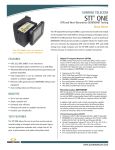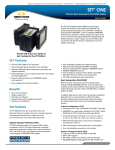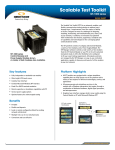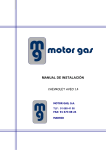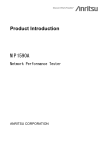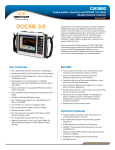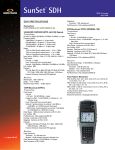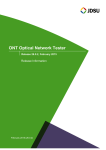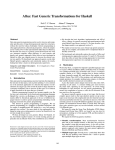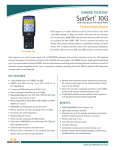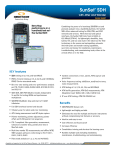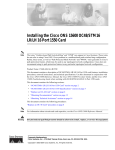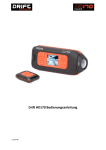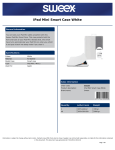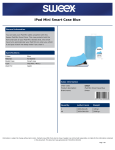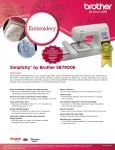Download STT 40G
Transcript
STT 40G 43G OTN and 40G SDH/SONET Testing Now with optional DPSK line coding The versatile and powerful STT 40G takes Sunrise Telecom’s Scalable Test Toolkit (STT®) platform to a new level as a test and measurement solution for high speed transport networks such as 43G OTN (OTU3) and 40G SDH/SONET (STM-256/OC-768). With payload structure down to VC12, VC11, VT1.5, and VT2, it offers service providers a complete test solution for today’s and tomorrow’s Metro, Core, and DWDM transport networks. In addition to it, STT 40G now offers 43G DPSK modulation with tunable transmitter for OTN Network Element client and line side field verification. Its small size and weight in stand alone mode makes the STT 40G the smallest and lightest test set in the world. This commanding set of features is available in a single, compact, easy to use, and cost effective unit. The STT 40G can be used independently or combined with other test modules to enhance its application, taking advantage of its bidirectional 10.7/10G drop and insert port. Like other STT modules the STT 40G offers the revolutionary and cost-effective stand-alone mode in remote or local environments, allowing test modules to operate at 100% of their capabilities and features, even when removed from the STT platform. Key Features • OTN, SDH, SONET in one instrument • Optional DPSK modulation for OTN NE line side verification in the field • 10/10.7G auxiliary port to interconnect STT 40G module with other 10G systems • Fully independent or can be combined with other test modules to enhance application • Internal SDH/SONET mapping down to VC12, VC11, V T1.5, VT2 • Complete performance tests and analysis for point to point links and DWDM networks • Comprehensive SDH/SONET/OTN overhead control and decode • Auto-configuration • Stand-alone operation (no platform required) increases portability and flexibility • Complies to ITU-T, Telcordia, and ANSI standards • Intuitive user-friendly, yet powerful, Graphical User Interface Benefits • All-in-one transport networks test solution • Cost-effective solution, as a stand-alone module, self-contained portable instrument, or as a 40/43G complement to existing STT ONE reducing CAPEX • Eliminates the need for multiple platforms • Increases availability of test gear as STT modules left behind can be used at 100% of their capabilities, while the test platform is being used in other application. • Native Remote Control operation that can work on low bandwidth conditions, offering the most responsive system in the market. The user-interface has been designed specifically for carrier, NEMs, and lab applications, maintaining the familiar look and feel of other STT products to reduce the learning curve and operational expenses. Auto configuration takes the guess-work out of configuring the instrument to the circuit being tested. Yet, experienced users will appreciate advanced features like overhead monitoring and control, APS timing measurement, pointer test sequences, and propagation delay measurement. Test Features With its comprehensive set of test and measurement features, the STT 40G allows the user to perform routine and advanced testing on high speed transport networks with a single platform. All measurements conform to industry standards, and circuit impairments are displayed on a correlated graphical view, giving operators insight into the possible causes of circuit impairments. By combining the STT 40G with STT ONE, it offers a cost effective solution for testing all transport networks from 1.5 or 2 Mbit/s up to 40/43 Gbit/s, eliminating the need for multiple platforms. • Same look and feel as other STT modules reduces the learning curve and operational expenditures • Ideal for Network Element installation, verification and troubleshooting www.sunrisetelecom.com Optical Transport Network (OTN) Applications STT 40G provides Forward Error Correction (FEC), verifies conformance to ITU-T G.709 and a wide range of network performance standards, including end-to-end connectivity at OTU3 bit rate, and complete synchronous/asynchronous mapping of SDH STM-256, SONET OC-768 client signals. STT 40G allows the user to perform testing on high-speed transport networks. Offering both in-service and out-of-service configurations, the STT 40G covers installation, commissioning, maintenance and troubleshooting applications. Among other advance features, it supports a comprehensive set of test modes including point-to-point, through modes, mux-test and mux emulation. Its complete error insertion and alarm generation selection can be used to verify network performance monitoring systems. Application oriented graphical user interface shows the building blocks and flow of the test signals as user friendly set up guide. • OTU3 (43 Gbit/s) interface • ODU Time Division Multiplexing (ODU2 into OPU3) • Synchronous/asynchronous mapping of SDH/SONET signals • OTN/SDH, OTN/SONET mux test and emulation • Error performance analysis per ITU-T G.8201 and M.2401 • APS timing measurement • Alarm Generation and Error Injection (including correctable and non-correctable FEC) • OTN Tandem Connection Monitoring • OTU, ODU, OPU error injection and alarm generation • OTU, ODU, and OPU bytes control and decode • Complies to ITU-T G.709 Traditional SDH/SONET • Mapping/demapping of payloads from VC4-64c/ STS-192c down to VC11, VC12/V T1.5, VT2 • SDH/SONET errors/alarms detection and generation Out-of-Service Testing OTN/SDH/SONET • SDH/SONET overhead control and decode • Pointer monitoring and adjustment • APS timing measurement • Alarm Generation and Error Injection • Complies to ITU, Telcordia, and ANSI standards • Bring-into-service, stress testing, and maintenance • Error performance analysis conforming to ITU-T and Telcordia recommendations 10/10.7G Auxiliary Port • End-to-end error free transmission verification • Field replaceable transceivers (XFP) • SDH/SONET network routing verification • OTU3 to OTU2 drop/insert • OTU3 to STM-64 or OC-192 drop/insert • STM-256 to STM-64 drop/inset In-Service Testing • OC-768 to OC-192 drop/insert OTN/SDH/SONET • Line and payload through mode monitoring • In-service monitoring through protected monitoring points or optical splitters • Overhead bytes monitoring and decoding • Pointer monitoring 2 STT 40G About STT Platform The Scalable Test Toolkit (STT) is an advanced, modular, and flexible testing solution that addresses Layer 1 through Layer 7 requirements, from fiber optics to Quality of Service. Designed to meet the challenges of designing, installing, maintaining, and troubleshooting core, metro, and access networks, the STT combines an innovative test platform with revolutionary test features, supporting a complete suite of capabilities and technologies for the converging global communications market. Mux Test OTN All STT modules are equipped with a unique standalone feature that allows them to operate at 100% of their capabilities outside of the platform, maximizing test resources. • OTN/SDH, OTN/SONET Mux/demux testing • Asynchronous and synchronous mapping of SDH/SONET client signals into OTU3 • STT ONE. OTN, EoS (Ethernet over SDH/SONET), NGN (VCAT, LCAS and GFP), legacy SDH/SONET and PDH/T-carrier testing. Transport testing from 1.5/2 Mbit/s up to 10/10.7 Gbit/s. Advanced next generation network testing, GigE frames drop/insert from SDH/SONET via GFP-T port, Packet Capture and export, In-service real time monitoring of SDH/SONET tributaries (Channel Master), APS testing. Legacy networks testing: VF, Pulse Mask. Network Element Verification OTN/SDH/SONET • STT Metro. 10/100/1000M Ethernet testing. Throughput and Bit Error testing across Layers 1, 2, and 3. Stacked VLAN (Q-in-Q) and MPLS. RFC 2544 benchmark testing. GPS antenna port for oneway latency measurements. IP connectivity testing. Bidirectional monitoring of live networks. Packet capture with decoding up to Layer 7. • Error injection, alarm generation to verify NE remote indication • FEC error generation to verify NE Forward Error Correction capabilities • SDH/SONET Pointer Test Sequences generation to test NE response to problems with sync • Frequency offset to stress clock recovery of NE • STT 10G Ethernet. 10 GigE LAN/WAN Ethernet testing. Throughput and Bit Error testing across Layers 1, 2, and 3. Advanced test features Stacked VLAN (Q-in-Q) and MPLS. RFC 2544 benchmark testing and packet capture and decode up to Layer 7. • ODU Time Division Multiplexing test DPSK NE Field Installation/Verification STT 40G Client NRZ Line NE 43G DPSK • DPSK line coding verification • Tunable DPSK transmitter for DWDM C-band verification • End to loopback client-to-line or line-to-client verification • Bi-directional client-to-line and line-to client verification with 2 test sets • OTN protocol verification www.sunrisetelecom.com 3 Specifications TEST INTERFACES SDH and SONET 43/40G Optical Test Port Port/Connector Universal interface with FC-PC and SC-PC adapters 40/43G NRZ (STT-8100/STT-8110) Transmitter Line coding: NRZ Single Mode 1550 nm Output power range 1550 nm, 2 km: 0 to +3 dBm Laser Safety: Class 1, IEC 60825-1, FDA/CDRH, 21 CFR 1040.10 and 1040.11 Bit rates 43.018413 Gbit/s ±4.6 ppm (OTU3) 39.81312 Gbit/s ±4.6 ppm (STM-256, OC-768) Clock source Internal Freq. offset: ± 50 ppm with 1, 0.1 ppm resolution Received Recovered from received signal External 2.048 Mbit/s (MTS/SETS) or 2.048 MHz (SDH) 1.544 Mbit/s (BITS) or 1.544 MHz (SONET) 64K+8K co-directional Complies to ITU-T G.709, G.693 VSR2000-3R2 Receiver Frequency recovery range 43.018413 Gbit/s ±50 ppm (OTU3) 39.81312 Gbit/s ±50 ppm (STM-256, OC-768) Jitter tolerance ITU-T G.825, G.783 GR-253-CORE Operational wavelength range 1290 to 1565 nm Receiver sensitivity is specified and guaranteed at 1550 nm Input power range 1550 nm Short Reach, PIN detector: -6 to +3 dBm Damage level: +7 dBm (peak) Complies to ITU-T G.709, G.693 VSR200-3R2, and G.8251 43G DPSK (STT-8120/STT-8130) Transmitter Line coding: NRZ-DPSK Single Mode Adjustable wavelength range 1528.77 – 1563.45 nm Frequency grid: 50 GHz per ITU-T G.694.1 Output power +3 dBm Bit rates 43.018413 Gbit/s ±4.6 ppm (OTU3) Clock source Internal Freq. offset: ± 50 ppm with 1, 0.1 ppm resolution Received Recovered from received signal External 2.048 Mbit/s (MTS/SETS) or 2.048 MHz (SDH) 1.544 Mbit/s (BITS) or 1.544 MHz (SONET) 64K+8K co-directional Complies to ITU-T G.709 4 STT 40G Receiver Frequency recovery range 43.018413 Gbit/s ±50 ppm (OTU3) Operational wavelength range 1528.77 – 1563.45 nm Receiver sensitivity is specified and guaranteed Input power range +2 to +10 dBm Damage level: +13 dBm (peak) 10.7/10G Auxiliary Port (STT-8110 /8130 Only) Uses field replaceable XFP transceiver modules Port/Connector: LC-PC Transmitter Line coding: NRZ Single Mode Optics Bit rates 10.70923 Gbit/s ±4.6 ppm (OTU2) 9.96328 Gbit/s ±4.6 ppm (STM-64, OC-192) Clock source Internal Recovered from 43/40G signal Receiver Frequency recovery range 10.70923 Gbit/s ±100 ppm (OTU2) 9.96328 Gbit/s ±100 ppm (STM-64, OC-192) Complies to ITU-T G.709 and G.959.1 SA586-1550MR XFP: 10G Mulit-rate transceiver (optional) Output power range 1550 nm: -1 to +2 dBm Laser Safety: Class 1, IEC 60825-1, FDA/CDRH, 21 CFR 1040.10 and 1040.11 Input power range Intermediate Reach, PIN detector: -14 to 0 dBm Saturation level: -1 dBm Operational wavelength range 1260 to 1565 nm Communication Channel and Clocks DCC/GCC Micro D-sub 9-pin DCC (D1-D3, D4-D12), GCC0, GCC1, or GCC2 Drop and Insert port External Clock Inputs BNC, 75 Ohms unbalanced 2 Mbit/s and 2 MHz Bantam, 100 Ohms balanced 1.5 Mbit/s and 1.5Mhz Bantam, 110 Ohms balanced 64 Kbits Reference Clock Output Connector: SMA, 50 Ohms unbalanced Signal: 200~450mV Frequency 43G: 2.7 GHz 40G: 2.5 GHz TEST FEATURES Application Modes Standards OTN, SDH, SONET, and Unframed (43/40G) *Unframed mode supports PRBS test patterns only Mux/Demux Test (40G/43G) Mux test Test pattern is generated on 40G sdh/sonet Tx and the ber test is performed on the 43G otn rx Demux test Test pattern is generated on 43G OTN Tx and the BER test is performed on the 40G sdh/sonet rx Measurement Modes Out-of-service (BERT) and In-service (Live) Tx and Rx Configuration Coupled: Tx and Rx are coupled together and have the same configuration Independent: Tx and Rx may be configured independently TEST MODES Point-to-point Mux/Demux Mode (40G/43G) Drop or insert an external 40G Sdh/sonet signal from/to 43G otn Unidirectional Tx and Rx are set to the same rate Internal mapping and multiplexing down to 2 and 1.5 Mbit/s tributaries Through Mode Operation Line through Monitors the entire signal as it passes through the instrument with no manipulation of overhead, errors, or alarms Overhead can be monitored Alarms and errors are measured 10/10.7G Drop and Insert (STT-8110 Only) Uses the Auxiliary 10/10.7G port for bidirectional STM-64/OC-192 or OTU2 payload drop and insert from STM-256/OC-768 or OTU3 signals to an STT ONE or another external test equipment, analyzer, simulator, or network element. Payload through Passes the payload (including poh) through the instrument with overhead manipulation Soh (sdh/sonet) and oTU/odu (otn) error insertion and alarm generation SOH (sdh/sonet) and otU/odu (otn) overhead control (except pointers) www.sunrisetelecom.com 5 OTN Tests and Measurements Frame/Payloads Frame and mapping structure conforms to ITU-T G.709 Synchronous and asynchronous mapping of SDH/SONET payloads and PRBS test signals Measurements Errors OTU: FAS (OA1, OA2), MFAS, SM-BIP-8, SM-BEI, SM-BDI, SM-BIAE, correctable FEC errors, uncorrectable FEC errors ODU: PM-BIP-8, PM-BEI TCM1-6: BIP-8, BEI Payload bit errors Alarms OTU: LOS, LOF, OOF, OOM, AIS, SM-TIM, SM-IAE, SM-BDI, SM-BIAE ODU: AIS, OCI, LCK, BDI, PM-TIM, PM-BDI OPU: PLM TCM1-6: OCI, AIS, LCK, TIM, BDI, IAE, LTC, SM-BDI, SM-BIAE Error performance analysis: ITU-T G.8201, M.2401 Overhead Features OTU Time Division Multiplexing Mappings ODU2 into OPU3 (internal and external) Flexible channel numbering: • Standard (G.709) • User selectable OPU3 timeslots ( 4 out of 16 ) External mapping (drop/insert or digital wrapper emulation mode) Selectable measurement side (high or low) OPU2 payloads STM-64 synchronous and asynchronous OC-192 synchronous and asynchronous, Bulk Mode. SONET/SDH payload mapping down to VC12, VC11 / VT1.5, VT2 bulk modes OPU2 payload scrambling Programmable payload frequency offset Test Patterns Framed mode PRBS: 231-1, 223-1, 220-1, 215-1 Fixed: all 1s, all 0s, alt 1010, 1-4 User: 10 programmable 16-bit user patterns. Pattern names up to 10 characters. Unframed mode Prbs: 231-1, 223-1, 220-1, 215-1 Test pattern inversion Error Injection Otu: fas (oa1, oa2), mfas, sm-bip-8, sm-bei, correctable fec errors, uncorrectable fec errors Odu: pm-bip-8, pm-bei Tcm1-6: bip-8, bei Payload bit errors Modes Single Burst: 1 to 8000 Rate: 1x10-9 to 2x10-3 (Options vary depending on configuration and error type) Alarm Generation Otu: los lof, oof, oom, ais, sm-tim, sm-iae, sm-bdi, sm-biae, Odu: ais, oci, lck, bdi, pm-tim, pm-bdi Tcm1-6: oci, ais, lck, tim, bdi, iae, ltc, sm-bdi, sm-biae modes Single Periodic (number of frames ON and OFF) Continuous (Options vary depending on configuration and alrm type) 6 STT 40G Overhead Monitor Hex display of all bytes (OTU, ODU, and OPU) Text decode of all applicable bytes TTI [SM (OTU), PM (ODU), TCM1-6], FTFL, APS/PCC, PSI Conforms to ITU-T G.709 Overhead Programming Hex input for all bytes except framing (FAS and MFAS), parity (BIP8, BEI) and justification (JC) Trail Trace Identifier (TTI) Generation SM (OTU), PM (ODU), TCM1-6: SAPI/DAPI 16 bytes E.164 ASCII sequence Operation bytes: 32 bytes HEX or E.164 ASCII sequence Automatic Protection Switching (APS)/Protection Communication Channel (PCC) bytes control & decode per ITU-T G.709 and G.873 Fault Type Fault Locator (FTFL) control and decode. Forward and backward field structure per ITU-T G.709 Payload Structure Identifier Payload type generation/decode: Hex mode or text mode Conforms to ITU-T G.709, PT decode requires locking to MF #1 Overhead Sequence Generation Bytes: TTI (SM, PM, TCM1-6), GCC0, GCC1, GCC2, APS/PCC, or any single overhead byte Generates up to 256 elements Overhead Sequence Capture OA1/OA2, TTI (SM, PM, TCM1-6), GCC0, GCC1, GCC2, APS/PCC, or any single overhead byte Captures up to 256 elements Automatic Protection Switch Time Measurement Resolution: 1 ms Accuracy: ± 3.035 μs Sensors: LOS, LOF, LOM, OTU-AIS, OTU-IAE, OTU-BIAE, OTU-BDI, ODU-AIS, ODU-OCI, ODU-LCK, ODU-BDI, OPU-PLM Pass/Fail indication Programmable switch time and gate time SDH Payloads Measurements VC4-256c Bulk, VC4-64c Bulk, VC4-16c Bulk, VC4-4c Bulk, VC4 Bulk, VC3 Bulk, VC12 Bulk, VC11 Bulk Errors FAS (# of Frame errors per Frame), Bit, B1, B2, B3, BIP-2, MS REI, HP/LP REI Alarms RS: LOS, LOF, OOF, RS-TIM MS: MS-AIS, MS-RDI AU: AU-AIS, AU-LOP HP: HP-AIS, HP-PLM, HP-ERDI (Payload, Server, Connectivity), HP-TIM, HP-UNEQ TU: TU-LOM, TU AIS, TU-LOP LP : LP-PLM, LP-ERDI (Payload, Server, Connectivity), LP-TIM, LP-UNEQ Error performance analysis ITU-T G.821, G.826, G.828, G.829, M.2101, M.2110, M.2120 Overhead Features Test Patterns Framed mode PRBS: 231-1, 223-1, 220-1, 215-1, 211-1, 29-1 Fixed: All 1s, All 0s, Alt 1010, 1-4 User: 10 programmable 16-bit user patterns. Pattern names up to 10 characters. Unframed mode PRBS: 231-1, 223-1, 220-1, 215-1 Test pattern inversion Error Injection Bit, FAS (Frame base), B1, B2, B3, LP-BIP, MS-REI, HP-REI, LP-REI Modes Single Burst: 1 to 8000 Rate: 1x10-9 to 2x10-3 (Options vary depending on configuration and alarm type) Alarm Generation RS: LOS, LOF, RS-TIM MS: MS-AIS, MS-RDI AU: AU-LOP, AU-AIS HP: HP-AIS, HP-UNEQ, HP-TIM, HP-RDI, HP-PLM, HP-ERDI (Payload, Server, Connectivity) TU: TU-LOP, TU-AIS, TU-LOM LP: LP-UNEQ, LP-TIM, LP-RDI, LP-PLM, LP-ERDI (Payload, Server, Connectivity) Modes Single Periodic (number of frames ON and OFF) Continuous (Options vary depending on configuration and alrm type) Overhead Monitor Hex display of all bytes (RS, MS, HP, and LP) Text decode of all applicable bytes (K1/K2, S1, C2, etc.) Overhead Programming Hex input for all bytes except parity (B1/B2/B3), pointers (H1-H3), and undefined bytes Text encoding of all applicable bytes (K1/K2, S1, C2, etc.) Overhead Sequence Generation Bytes: J0/J1/J2, K1/K2, or any single overhead byte Generates up to 16 elements Overhead Sequence Capture Capture: J0/J1/J2, K1/K2 (2 bytes), or any single overhead byte Each new value is captured with a timestamp (absolute or elapsed) and duration (in ms or frames) Trigger: Manual or user-defined value Resolution: 125 µs (1 frame) Captures up to 256 elements Trace Generation J0 Section trace: 1 byte, 16 bytes, E.164/ASCII sequence + CRC-7 or 64 bytes E.164/ASCII sequence J1/J2 Path trace: 16 bytes E.164/ASCII sequence + CRC-7 or 64 bytes E.164/ASCII sequence Selection: Default, user, or through Pointer Monitor AU/TU Instantaneous pointer value display Loss of pointer seconds Total justification count Positive justification count Negative justification count New Data Flag (NDF) seconds Pointer Adjustment Programming of AU/TU pointer value, NDF, and SS bits Pointer increase or decrease www.sunrisetelecom.com 7 Pointer Test Sequences Alarm Generation Standard: ITU-T G.783 Sequences: Single, burst, phase transient burst, periodic, 87-3, 26-1, opposite, and custom Movement: Increase, decrease, increase + decrease Anomalies: Added, cancel, and none Frequency offset: Positive, negative, and none Sequence timing: Initialization, cool down, and measurement LOS, LOF, TIM-S/P, AIS-L/P, RDI-L/P, ERDI-P, LOP-P, PLM-P, UNEQ-P, RDI-V, LOM-V, UNEQ-V, AIS-V, LOP-V, TIM-V, RDI-V, ERDI-V, PLM-V Modes Single Periodic (number of frames ON and OFF) Continuous (Options vary depending on configuration and alarm type) Automatic Protection Switch Time Measurement Measurements Resolution: 1 ms Accuracy: ±125 µs Sensors: LOS, LOF, MS-AIS, MS-RDI, AU-AIS, HP-RDI, LP-RDI, TU-AIS, Pass/Fail indication Programmable switch time and gate time Errors FAS (# errors per frame), B1 (CV-S), B2 (CV-L), B3 (CV-P), BIP-V (CV-V), REI-V, REI-L, REI-P Alarms LOS, LOF, TIM-S/P, AIS-L/P, RDI-L/P, ERDI-P, LOP-P, PLM-P, UNEQ-P, RDI-V, LOM-V, UNEQ-V, AIS-V, LOP-V, TIM-V, RDI-V, ERDI-V, PLM-V, TIM-P Failure indications for all alarms Error performance analysis Telcordia GR-253-CORE Section: SEFS-S, CV-S (B1), ES-S, SES-S Line near end: CV-L (B2), ES-L, SES-L, UAS-L, FC-L Line far end: CV-LFE (REI-L), ES-LFE, SES-LFE, UAS-LFE, FC-LFE Path near end: CV-P (B3), ES-P, SES-P, UAS-P, FC-P Path far end: CV-PFE (REI-P), ES-PFE, SES-PFE, UAS-PFE, FC-PFE, CV-P (BIP), ES-V, SES-V, UAS-V, FC-V, CV-PFE (REI-V), ES-VFE, SES-VFE, UAS-VFE, FC-VFE, CV-V (BIP), ES-V, SES-V, UAS-V, FC-V Pointers: PPJC-P Det, NPJC-P Det, PPJC-P Gen, NPJC-P Gen, PJC Diff-P, PJCS-P Det, PJCS-P Gen, plus Pointer Value and NDF-P seconds; PPJC-V Det, NPJC-V Det, PPJC-V Gen, NPJC-V Gen, PJC Diff-V, PJCS-V Det, PJCS-V Gen, plus Pointer Value and NDF-V seconds SONET Payloads STS-768c SPE, STS-192c SPE, STS-48c SPE, STS-12c SPE, STS-3c SPE, STS-1 SPE, VT2 Bulk, VT1.5 Bulk Overhead Features Test Patterns Framed mode PRBS: 231-1, 223-1, 220-1, 215-1, 211-1, 29-1 Fixed: All 1s, All 0s, Alt 1010, 1-4 User: 10 programmable 16-bit user patterns. Pattern names up to 10 characters. Unframed mode PRBS: 231-1, 223-1, 220-1, 215-1 Test pattern inversion Error Injection Bit, FAS (# errors per frame), B1 (CV-S), B2 (CV-L), B3 (CV-P), BIP-V (CV-V), REI-V, REI-L, REI-P Modes Single Burst: 1 to 8000 Rate: 1x10-9 to 2x10-3 (Options vary depending on configuration and error type) 8 STT 40G Overhead Monitor Hex display of all bytes Text decode of all applicable bytes (K1/K2, S1, C2, etc.) Overhead Programming Hex input for all bytes except parity (B1/B2/B3), pointers (H1-H3), and undefined bytes Text encoding of all applicable bytes (K1/K2, S1, C2, etc.) Overhead Sequence Generation Bytes: J0/J1/J2, K1/K2, or any single overhead byte Generates up to 16 elements Overhead Sequence Capture Capture: J0/J1/J2, K1/K2 (2 bytes), or any single overhead byte Each new value is captured with a timestamp (absolute or elapsed) and duration (in ms or frames) Trigger: Manual or user-defined value Resolution: 125 µs (1 frame) Captures up to 256 elements Trace Generation J0 Section trace: 1 byte, 16 bytes, E.164/ASCII sequence + CRC-7 or 64 bytes E.164/ASCII sequence J1/J2 Path trace: 16 bytes E.164/ASCII sequence + CRC-7 or 64 bytes E.164/ASCII sequence Selection: Default, user, or through Pointer Monitor Instantaneous pointer value display Loss of pointer seconds Total justification count Positive justification count Negative justification count New Data Flag (NDF) seconds Pointer Adjustment Programming of STS and VT pointer values, NDF, and SS bits Pointer increase or decrease Common to OTN, SDH and SONET Measurements Optical power level measurement Accuracy: ± 3 dB Wavelength: 1550 nm Receiver sensitivity and optical power measurement accuracy are specified and guaranteed at 1550 nm Optical saturation indication Histogram analysis and bar graph correlation Errors/Alarms/Pointer/Clock graphic display in real time Stores current results with 1-second resolution for the last 12 hrs, 1-minute resolution for the last 72 hrs, and 15-minute resolution for the last 60 days Compare two parameters to visually detect correlation Pointer Test Sequences Standard: ANSI T1.105.03, Telcordia GR-253 Sequences: Single, burst, phase transient burst, periodic, 87-3, 26-1, opposite, and custom Movement: Increase, decrease, increase + decrease Anomalies: Added, cancel, and none Frequency offset: Positive, negative, and none Sequence timing: Initialization, cool down, and measurement Automatic Protection Switch Time Measurement Resolution: 1 millisecond Sensors: LOS, LOF, AIS-L, AIS-V, RDI-L, AIS-P, REI-L, RDI-P, RDI-V, Pass/Fail indication Programmable switch time and gate time Frequency Current, maximum, minimum frequency offset (ppm) Events log with 100 ms time stamps Tracks individual events, sequence and severity count Full screen status Detailed overview Large color coded Alarm/Error Service disruption measurement Programmable error-free test window: 1-3000ms Minimum disruption time: 50 µs Minimum defect time: 50 µs Longest, shortest, last and total counters Available for PRBS only www.sunrisetelecom.com 9 Measurement Settings Continuous measurement Programmable start time and duration Elapsed time, remaining time display Auto-configuration (40/43G Only) Automatically determines rate framing, payload structure, and test pattern Configures Tx to match the received signal Save, view, and reload configuration profiles GENERAL Instrument Mode Self-contained portable instrument, using attached STT Controller and power supply Measurement Results Management Open Opens previously saved or archived measurement results Print Prints measurement results Export Export measurement results reports file to comma separated values (which can be read by text editors, word processors, or spreadsheet program), XML or text formats Test records can be exported to hard drive or USB memory Archive Moves test records to the hard drive in raw format Test records can be opened in other instruments or PCs to be analyzed in its native format (require the STT 40G software) Archive All option Test records View Lock and Unlock Delete and Delete All Rename STT Reporter Generates PDF reports with user-customizable headers, contact information, logo, case information, and comments Stand-alone Mode Remote or local operation using a networked PC or direct Ethernet connection Requires SA427 stand-alone kit Automatic discovery of all test modules in the same network Multiple units within the same network can be controlled from one PC Offers 100% of its capabilities Software upgrades via USB memory or LAN (through STT Controller or PC) TL1 commands for remote operation and test automation Admin Serial Port Built-in DB-9 for service, diagnostics, and TL1 Ethernet Port Built-in RJ-45, 10/100BaseT for service, diagnostics, TL1, and remote operation Power requirements Consumption: 110 watts (module only) Power supplies Compatible with STT-1525 and SA427; 100~240Vac, 50~60Hz (check with manufacturer for other options available) Battery backup with STT-1525, for uninterrupted measurements Environmental CE Mark: Conforms to the applicable sections of 98/63/EEC Operating temperature: 32 to 104°F (0 to 40°C) Storage temperature: -4 to 158°F (-20 to 70°C) Humidity: 5% to 85% non-condensing Dimensions Size: 12.6 x 8.7 x 4.4 in (320 x 220 x 110 mm) Weight: 8.8 lbs (4.0 kg) 10 STT 40G Ordering Information Control Module STT 40G Test Module STT-1001 ������������ STT Control Module [STT Control and Display Module with Windows XP Professional OS. Includes STT Manager Software (STT-1000-SW1), STT User’s Manual. (SA920), Qty 2 Stylus (SA142), STT bus bridge case (SA144), Small Accessory Storage case (SA149. Requires STT Power Module and Test Module(s)] STT-8100������������ STT 40G Module OTN/SDH/SONET 40/43G analysis at OTU3, STM256, and OC-768. Offers 40/43G optical interface. [Includes: 40/43G Single Wavelength, 1550 nm Short Reach Tx/Rx optical transceiver; Standard universal optical connector base with UPC termination; 2x SA527 FC adapter for Universal Optical connector; 2x SA528 SC adapter for Universal Optical connector; SA918 STT 40G Users’ Manual CD-ROM, one-year standard warranty and Certificate of Calibration] Power Modules STT-1501 ������������ Power Module, AC. 216 Watt maximum output STT-1521 ������������ Power Module, AC. 340 Watt maximum output STT-1525 ������������ Power Module, AC and Battery. 150 Watt maximum output SA427���������������� STT Stand-Alone Accessory Package. 130 Watt maximum output [Includes: SA170 130 Watt external AC/DC Power Adapter; SA265 100 Ohm, CAT 5, RJ45 (m) to RJ45 (m), Cross-over 6’ cable; SA266 Cable; 100 Ohm, CAT 5, RJ45 (m) to RJ45 (m), Straight 6’ cable; SA144 STT Bus Case; 4x Screw-on feet] SA155-UK���������� 3-prong power cord for use in United Kingdom. SA155-EU ���������� 2-Prong power cord plus ground for use in Europe (Except UK) SA155-NA �������� 3-prong power cord for use in Latin America, North America, and Asia SA155-SW���������� 3-prong power cord for use in Switzerland SA155-SA���������� 3-prong power cord for use in South Africa/India 10/10.7G XFP Optics Options for STT-8110 SA586-1550MR�� XFP: 10G Multi-rate Transceiver [1550 nm Single-mode, 40km, 9.95Gb/s to 10.7Gb/s transceiver plug-in for 10GBASE-ER/EW and FEC, 10G Fibre Channel, OC-192/STM-64 IR, OTU2. LC Connector.] STT-8110������������ STT 40G Module with 10/10.7G port OTN/SDH/SONET 40/43G analysis at OTU3, STM-256, and OC-768. Offers 40/43G optical interface and 10/10.7G auxiliary XFP port for external drop/insert applications. [Includes: 40/43G Single Wavelength, 1550 nm Short Reach Tx/Rx optical transceiver; Standard universal optical connector base with UPC termination; 2x SA527 FC adapter for Universal Optical connector; 2x SA528 SC adapter for Universal Optical connector; SA918 STT 40G Users’ Manual CD-ROM, one-year standard warranty and Certificate of Calibration. Requires optional XFP optical transceiver modules for 10/10.7G] STT-8120 ��������� STT 40G Module 43G DPSK OTN 43G analysis at OTU3 with STM-256/OC-768 client signals. Offers 43G DPSK optical interface and tunable Tx. [Includes: Standard universal optical connector base with UPC termination; 2x SA527 FC adapters for Universal Optical connector; 2x SA528 SC adapters for Universal Optical connector; SA919 STT 40G Users’ Manual (SA919), one-year standard warranty and Certificate of Calibration] STT-8130������������ STT 40G Module 43G DPSK OTN 43G analysis at OTU3 with STM-256/OC-768 client signals. Offers 43G DPSK optical interface, tunable Tx and 10/10.7G auxilliary XFP socket for Drop/Insert. [Includes: Standard universal optical connector base with UPC termination; 2x SA527 FC adapters for Universal Optical connector; 2x SA528 SC adapters for Universal Optical connector; SA919 STT 40G Users’ Manual (SA919), one-year standard warranty and Certificate of Calibration] www.sunrisetelecom.com 11 Warranty Universal Connector Adapters SSTT-8100-W1������ STT 40G Model OTN/SDH/SONET40/43G, Standard Warranty SA527 �������������������� FC adapter for Universal Optical connector STT-8100-EW1������ STT 40G, 1 Yr Extended Warranty STT-8100-EW2������ STT 40G, 2 Yrs Extended Warranty STT-8110-W1�������� STT 40G Model w/10/10.75G,Port, Standard Warranty STT-8110-EW1������ STT 40G, 1 Yr Extended Warranty STT-8110-EW2������ STT 40G, 2 Yrs Extended Warranty STT-8120-W1������ STT 40G MODULE 43G DPSK, Standard Warranty STT-8120-EW1������ STT 40G, 1 Yr Extended Warranty STT-8120-EW2������ STT 40G, 2 Yrs Extended Warranty STT-8130-W1�������� STT 40G MODULE 43G DPSK, with 10G PORT, Standard Warranty STT-8130-EW1������ STT 40G, 1 Yr Extended Warranty SA528 �������������������� SC adapter for Universal Optical connector SA529 �������������������� LC adapter for Universal Optical connector [Check with factory for availability and lead time] SA530 �������������������� ST adapter for Universal Optical connector [Check with factory for availability and lead time] SA532 �������������������� DIN adapter for Universal Optical connector [Check with factory for availability and lead time] Other Accessories SA620 �������������������� Semi-rigid Carrying Case with wheels and telescoping handle SA622 �������������������� Hard Carrying Case with Wheels for STT Replacement Parts SA170 �������������������� STT Power Supply for stand-alone mode. 130 Watt maximum output SA918 �������������������� STT 40G User’s Manual CD-ROM STT-8130-EW2������ STT 40G, 2 Yrs Extended Warranty Important Notice: This product may contain technologies regulated by U.S. export control law. In the case of the export of product(s) and/or technologies described in this document, please take the appropriate procedure in conforming to all regulations related to the export. ECCN 5B001.b.1 : Telecommunications & information security; test, inspection and production equipment. For more information or a directory of sales offices: Phone: +1-800-701-5208 or +1-408-363-8000 info@sunr isetelecom.com I www.sunr isetelecom.com © 2012 Sunrise Telecom Incorporated. All rights reserved. Specifications subject to change without notice. All product and company names are trademarks of their respective corporations. Sunrise Telecom San Jose and Taiwan facilities are ISO 9001 certified. Do not reproduce, redistribute, or repost without written permission from Sunrise Telecom. STT 40G Data Sheet C_0088 June 11, 2012












